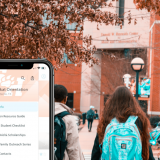Making the Most of Social Media for Universities
Social media usage has reached unprecedented numbers. Without a considerable online presence, your organization could easily slip right under the radar. This is no different for universities who are looking to connect to students online. Studies have found that 88% of U.S. adults ages 18-29 are on social media in 2018. This might have come as a surprise in 2005, when the same survey found that only 7% did of the same age group, but social media usage has grown steadily year over year with Facebook, Instagram, YouTube, and Twitter being the most popular sites for young adults.
With so many mobile users (ages 18-29) having some sort of mobile presence (for nearly two hours a day), incorporating social media into student outreach is a strategic move for universities.
Here are a few ways for schools to make the most of their social channels.
Reputation

Brand recognition! You want students to have heard of you and to easily recognize your school’s mascot and colors. Across all platforms, photos and icons are easily customizable to match a school’s look and feel. Social is a great platform for schools to blast the unique exciting events and programs that they host!
Texas A&M is home to one of the top video game design programs in the nation! #tamu
7️⃣th among public schools
2️⃣1️⃣st overall
5️⃣th for master’s degrees
??: https://t.co/fWugSgl64o pic.twitter.com/lnJccv0yXH— Texas A&M University (@TAMU) July 31, 2018
It is a simple way for schools to establish their “personality” and show students that besides being a globally acclaimed institution of excellence, they are also friendly and relatable.
Happy #InternationalCatDay from Remy the Harvard cat! (Thanks for the great pics, Remy! https://t.co/KCe9GyI6so) pic.twitter.com/3gxIhJGEqe
— Harvard University (@Harvard) August 8, 2018
With digital being one of the main channels of communication nowadays, schools who are not online could be seen as archaic or behind the times.
A Friendly Reminder

As many reminisce about their time in college as “the good ol’ days,” they may also remember that it was a time for deadlines. Whether it was for midterms, adding or dropping classes, enrolling in student aid, or turning in an essay, college is riddled with deadlines. University departments can utilize their social handles to provide their current and prospective students with friendly little reminders! Since they’ll be on a social feed that students are already checking, it’s unobtrusive and helpful.
For example, a financial aid department posts statuses to gently remind students to submit their FAFSAs in time!
Emergency Alerts

Although most schools should have an emergency alert system in place, social media is an effective way to make announcements or release important information that may have been missed. IDC Research found that 80% of smartphone users check their phones within 15 minutes of waking up. This can be very handy knowledge to take advantage of! Before students make the effort to get up and get onto campus, you can let them know that there’s a power outage at the libraryl or that a flock of migrating wild turkeys is blocking the southeast road.
Let’s Connect

Socializing on social media is one of the main reasons for a university to be online. Sharing ideas, thoughts, and information is perhaps the reason why social media was born in the first place. By creating a presence and space online, a university also opens up the opportunity for students to connect with each other and foster a community. With social, first years get the opportunity to network with others before they’ve even met in person. Proud sports fans can continue to root for their team on or off the bleachers.
Guidebook’s mobile app platform, Builder, enables organizations to easily create a mobile app. One of our features includes integrating with social media handles, as well as creating a feed of relevant tracked hashtags. Using branded hashtags on social media is a great strategy for organizations to elicit comradery between students, as well as categorize relevant posts in a searchable feed!
Online presence is especially important for prospective students. Did you know that 81% of consumers conduct research online prior to making a purchase? This is no different for services and institutions! Consumers rate every service that they use online now, from post offices to pre-schools. Students are taking to social media to share their experiences with other curious colleagues. Your lifestyle vloggers have started sharing videos explaining the “recipe” of how they got into a certain university as well as first-years filming their move-in and dorm decorating process. Social media may be the first touch that a prospect gets of your university even before they’ve set foot onto campus.
Measuring Success and Eliciting Feedback

Online is a place where many people, including students, feel safe to voice their opinions. Since it is easily accessible and can be done on their own time, it’s an optimal place to send surveys and polls to students. Because they are already on their phones, chances are that students might actually complete the survey since it’s more convenient for them as opposed to staying behind a class or session to manually fill out a piece of paper with a pencil.
The digital shift has also affected the way that consumers report dissatisfaction and how we share current events. Sprout Social found that 55% of people complain to organizations online because they expect better results than doing so in-person. This movement is called “Call-Out Culture” where many online denizens are coming to social media to confront organizations. With the prospect of exposure and network sharing, 70% of people do it because they want to draw attention to the problem publically and raise awareness.
If there are complaints online, individuals will present them by tagging the university or sending them a direct message on their social platform. Even if a department prefers to further address the problem through e-mail or in-person, it is detrimental that they are active on social media in order to receive that first contact.
However, people don’t come online just to complain. Social media is where many come to share their memories and experiences online. Encourage students to show off their school spirit at events and games! Like, share, and repost to strengthen culture and branding.
Apps and Social Media
With social media and mobile technology so ingrained in our everyday lives, it would be impossible to do any sort of business without it. Although it may take some work and time to integrate social media into their strategies, universities are lucky in the sense that their target audience are already so active and well-versed in it.
Universities can boost the success of their programs and efforts by not only maintaining an online presence, but creating mobile apps. Mobile technology allows for schools to modernize their departments and communicate with students in a more effective manner.
Guidebook easily enables schools of any size to build beautiful university mobile apps with no technical knowledge. Click the button below to try out one of our many school templates and start building!



